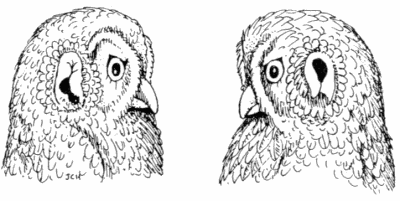 |
Science Frontiers ONLINE No. 138: NOV-DEC 2001 |
|
|
Remarkable Animal Talents And Capabilities
The arthropods, however, still find photoreceptors useful. Crayfish have them on their abdomens, where they initiate an escape response when illuminated. Additionally, the blind shrimp that collect around the glowing deep-sea vents have photoreceptors perched on their backs, presumably to guide them to their prey located around the luminous vents.
Recently, the Japanese yellow swallowtail butterflies were discovered to sport photoreceptors on their genitalia. These I are used during mating to confirm the position of the female's ovipositor.(Arikawa, Kentaro; "Hindsight of Butterflies," BioScience, 51:219, 2001.)
Barn-Owl auditory neurons multiple signals. Barn Owls can locate rustling mice in the dark with high precision. They discern their prey by sound rather than light. To achieve the high accuracy needed to home in on small rodents in the black of night, their ears are slightly offset so that they can draw a bead by using microsecond time-of-arrival differences in the sounds coming from the target. To increase the owl's passive sonar, their auditory neurons multiply the signals instead of adding them as do other neurons. In effect, they create an "auditory map" of their surroundings. On their high-precision auditory maps, a rustling mouse would be highlighted.
So far, though, biologists have not learned how neurons can multiply signals.
 The asymmetrical design of the Barn Owl's ears is essential for pinpointing its prey in the dark. (From: Biological Anomalies: Birds) |
(Helmuth, Laura; "Location Neurons Do Advanced Math," Science, 292:185, 2001.)
Hornets Install Magnetic Markers. Hornets of the species Vespa orientalis affix a tiny crystal of magnetic mineral in the roof of each of the brood-rearing cells in their nests. These crystals are roundish and about 0.1 millimeter in diameter. The mineral is ilmenite with the formula: FeTiO3.
The purpose of the magnetic crystals is obscure. The favored explanation is that the hornets use them as guides during nest construction -- sort of like those little flags human surveyors set out. This explanation assumes that hornets can somehow sense and make use of the complex magnetic field created by an array of many tiny magnets.
Another question asks where the magnetic crystals come from. Do the hornets secrete them like the magnetotactic bacteria or do they gather them from their environments?
(Stokroos, Ietse, et al; "Keystone-Like Crystals in Cells of Hornet Combs," Nature, 411:654, 2001.) Comment. It would be so easy to dismiss the hornets' little crystals as just one more animal gee-whiz fact, but we should not. Did the hornets first recognize that magnetic crystals would be useful to them and then set out to find some or, even more remarkably, evolve the ability to secrete them? Did their (presumed) magnetic sense evolve solely for the purpose of employing magnetic markers during nest building? There are more questions, but you get the idea.
Other Sites of Interest
|